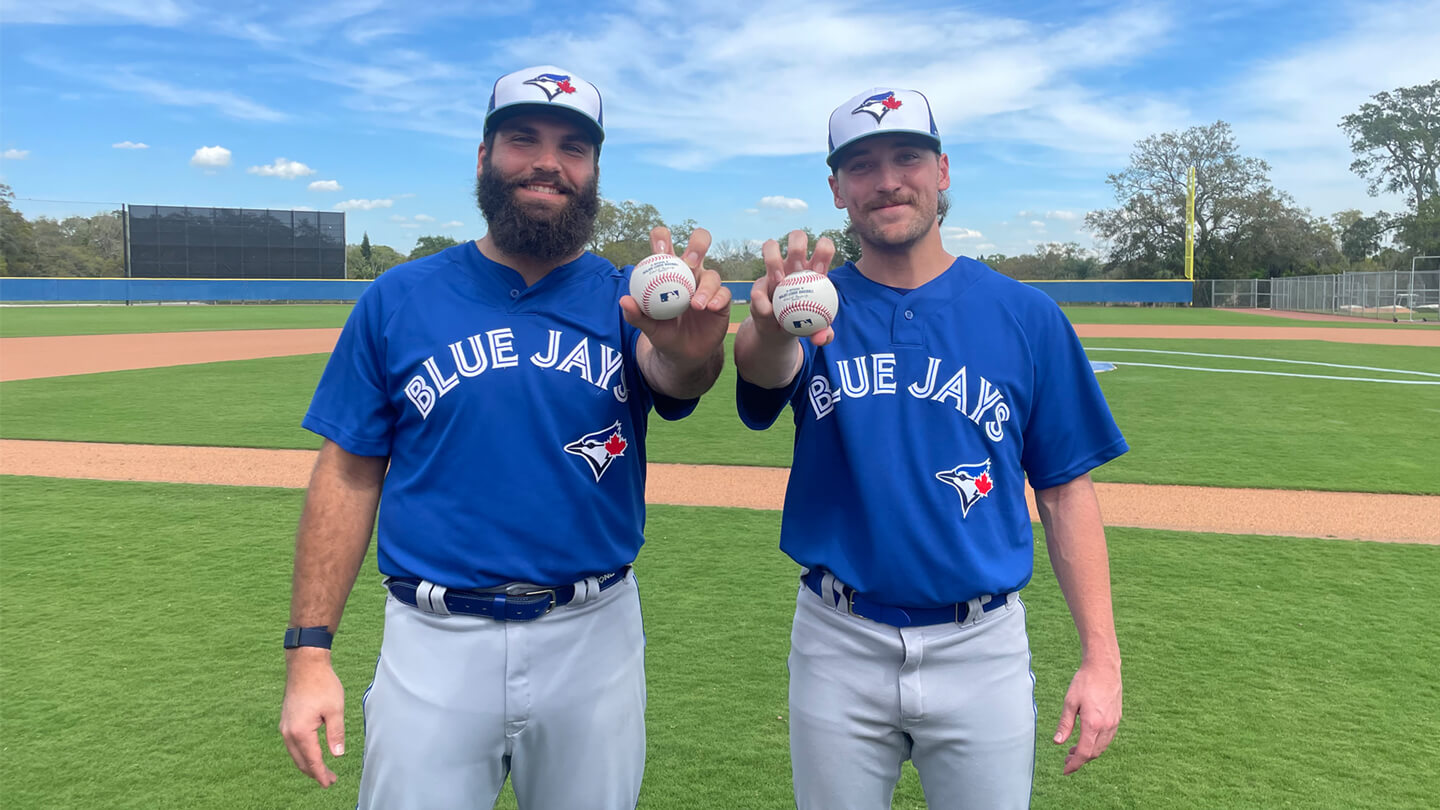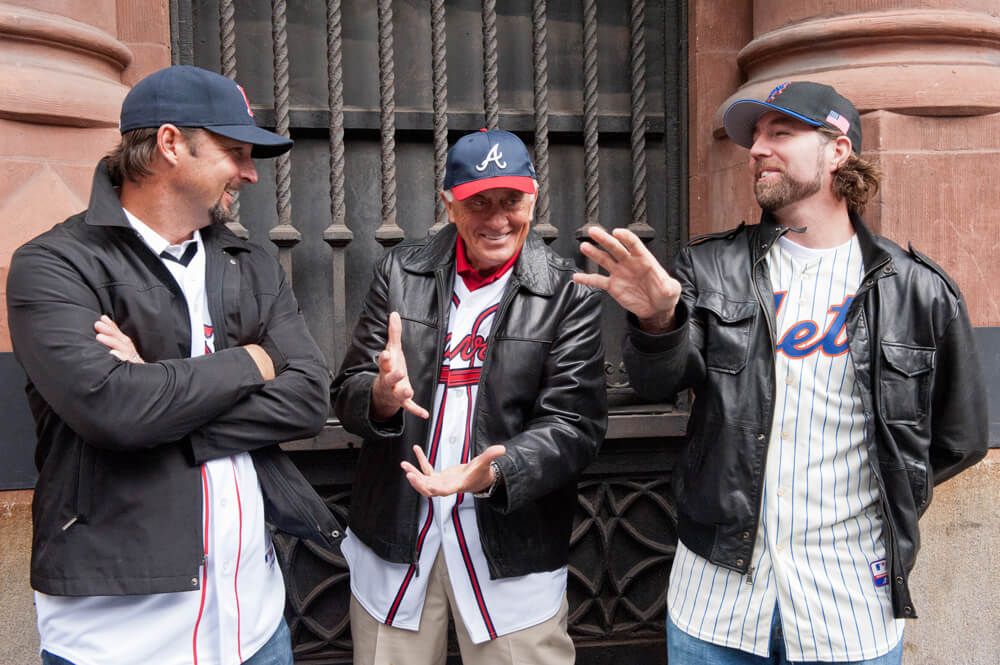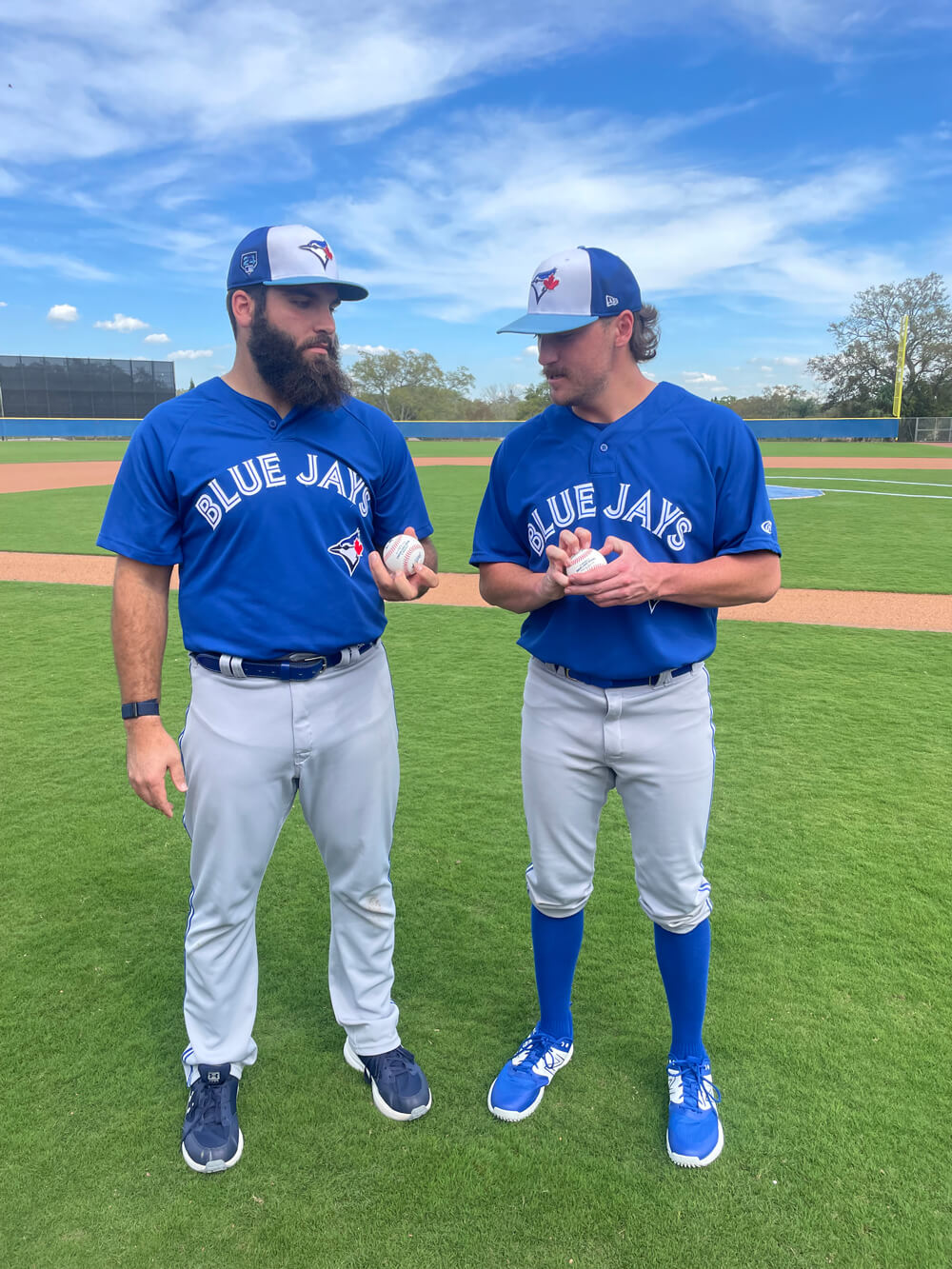
WELCOME TO THE CLUB

I
t was late July of 2008 when R.A. Dickey got an unexpected invitation from Tim Wakefield. Dickey was in the big leagues with the Seattle Mariners at the time, trying to extend his new, precarious career as a knuckleballer but struggling to find consistency. Wakefield, then 41 and in his 16th MLB season, was the most successful knuckleballer of his generation. When it came to mastering baseball’s least predictable pitch, they were far from equals, yet when Wakefield’s Red Sox visited Seattle, the older knuckleballer offered Dickey the chance to join him in the visitors’ bullpen and watch one of his throwing sessions up close. To Dickey, the gesture meant something. They were competing, sure, but Wakefield’s invitation represented an acknowledgement of sorts: because of the pitch we throw, we have something significant in common.
“At times, the mental part of trying to do this can be really difficult. You can feel very lonely.” Dickey recalls. “I’m trying to beat him, and yet he’s sharing with me some of the things that made him do so well with the craft.”
Thanks to Wakefield, Charlie Hough and Phil Niekro, Dickey would eventually develop what he describes as a “Jedi counsel” of knuckleballers available on speed dial. Two years after watching Wakefield’s bullpen session, Dickey would post an impressive 2.84 ERA in 26 starts for the New York Mets. Two years after that, he’d win the Cy Young Award, becoming the first knuckleballer recognized as his league’s best pitcher. It’s an individual accolade, of course, but one Dickey says he never would have won without the shared wisdom of the knuckleballers who preceded him.
These days, Dickey’s a 49-year-old father of four who coaches baseball and tends to his 40-acre farm in Tennessee. Since his playing career ended in 2017, he’s essentially stayed out of the public eye. But last year, he got another intriguing invitation, this one from Toronto assistant GM Joe Sheehan. The Blue Jays had a minor-league pitcher experimenting with a knuckleball. He was promising but had a long way to go. Might Dickey take some time to speak with this player he’d never met or heard of? A FaceTime call maybe? Or offer a few pointers via text?
Sheehan, it turned out, had asked the right guy. Dickey was happy to talk shop with the prospective knuckleballer, and before long stepped It up to working with him in person. And when the Blue Jays added a second knuckleballer to the organization a few months later, the remarkably niche development work gained even more momentum.
“What I enjoy the most is giving away what I’ve been given,” Dickey says. “There’s not a man among us that was a self-made man. We’re all the product of people who poured into us and loved us well.
“And I want this pitch to go on. It’s mystic, man.”

R
yan Chasse’s 2023 season didn’t go according to plan. A 17th-round pick in 2022, he was far from a top prospect even before injuries limited him to 24.2 innings in what should have been his first full season at Class A — he also walked nearly a batter per inning. Bearded, soft-spoken, and intensely competitive, the 24-year-old Chasse realized he was getting passed by younger pitchers who threw harder with nastier breaking stuff. If the six-foot-three left-hander was going to succeed, he needed to get creative about his future and try something else.
Ever since he was eight or nine years old, Chasse had toyed with a knuckleball, but he’d never dared use one in a game. Instead, he’d preferred to reach back for 91-92 on his fastball to try to overpower hitters, a strategy that just hadn’t worked as well as he’d hoped. Last spring, though, Blue Jays pitching coordinator Cory Popham saw him throwing a knuckler and encouraged him to test it at the team’s Dunedin, Fla. pitching lab. It looked cool, fluttering in around 70 m.p.h., like Wakefield’s once did.
Chasse was intrigued, and the Blue Jays were, too. Early in the spring of 2023, Sheehan reached out to Dickey in case he was willing to help. At first, the commitment was minimal — just an introductory FaceTime call — but as Chasse’s season slipped away, a new possibility emerged. Now, the Blue Jays were most interested in Chasse as a knuckleballer. He was up for the challenge, but he’d need some help.
Once the minor-league season ended, Sheehan circled back to Dickey and explained that Chasse was now more serious about the pitch than ever. Intrigued, Dickey offered to take his consulting role to another level. If an aspiring knuckleballer was asking for help, he wasn’t about to refuse. This time, he wanted to make the trip to see Chasse in person.
In October, the visit happened and suddenly Chasse, a lifelong baseball fan, was having conversations at the Blue Jays’ player development facility that barely felt real. The man he refers to as “Mr. Dickey” was there beside him, watching his mechanics, giving him nail care products to try and offering to review video footage at any time.
“It was really big for me,” Chasse says. “This is not something I’ve done a lot. And I mean, he’s the best there is that’s still alive. That’s going to help. So having him here was huge for me, confidence-wise and technique-wise.”
Already, Chasse was making some real strides. The Blue Jays clearly believed in him enough to fly in a Cy Young winner, and Dickey’s pointers were proving invaluable. After a frustrating season, these were meaningful steps. Even so, once Dickey left, Chasse would occasionally find himself wondering ‘What am I doing wrong?’ after a particularly frustrating day.
Soon enough, though, he’d have someone to share those doubts and frustrations with — someone who understood them as well as Chasse.

J
ordan Powell likes to have fun. He’s the type to get teammates together for an event and joke around in the locker room. The way he sees it, the baseball season’s just too long to be serious all the time.
Last year, though, wasn’t an especially fun time for Powell. His grandfather passed away, and the loss hit him hard. Plus, he was out of baseball. Not just out of affiliated baseball — the six-foot-two right-hander went undrafted — but out of baseball, period. The last team he’d played for, the independent Northern Colorado Owlz, released him.
“I was a stock righty,” he says now, smiling broadly. “Below-average curveball, below-average everything else. And everybody [else]’s throwing 99. I was like, ‘I’ve got to do something to get on a team.’”
His stuff may have been ordinary, but his motivation was exceptional. A native of Celebration, Fla., Powell kept pitching at Tread Athletics near Charlotte, N.C. and drove nearly 100,000 kilometres that summer trying to get signed. But a right-hander who throws 93-95 m.p.h. on a good day is no longer remarkable in today’s game, and at 25 years old, he was hardly an up-and-coming prospect.
Determined to try anything that might attract attention from big-league teams, Powell broke out his knuckleball, a pitch he’d messed around with as a kid when his hands were too small to throw a change-up. Pitching in indy ball, he’d even used the pitch in some games, generating whiffs from surprised hitters with a Dickey-esque power knuckler that could reach 78-80 m.p.h.
After a bullpen session with motion capture technology at Tread Athletics, the facility’s co-founder, Ben Brewster, shared the video on X with a caption that functioned as a sales pitch: “Here’s Jordan Powell sitting in the low 90s with absolutely disgusting knuckleballs,” Brewster wrote, adding a butterfly emoji to emphasize the pitch’s unusual movement.
The video was posted on January 16 of this year. Sheehan saw it soon afterwards, and within a week, Powell was officially a member of the Blue Jays organization. Just like that, there were two knuckleballers in a farm system that had previously had zero. Now, a plan could really take shape, one that could benefit not only Powell but Chasse, too.
Remember, fewer than 100 pitchers have ever mastered the knuckleball at the big-league level. Despite the recent uptick in pitching experts hired by big-league organizations, even the game’s most sought-after coaches have their limits here. With that in mind, the Blue Jays wanted to see if there was a way to pair two knuckleballers together. Powell didn’t need much convincing — he was just grateful for the job — but if he had, the benefits of collaborating with a second knuckleballer and a former Cy Young winner would have featured prominently in the Blue Jays’ recruitment strategy.
As Dickey explains, “you can’t just turn to your pitching coach and say ‘Hey man, help me with this knuckleball.’ There are few people who have walked the face of the earth that know how to throw one the right way, and sometimes getting a hold of those guys can be really tough. It’s a tight fraternity.”
Early this spring, Dickey made a second visit to Dunedin, so he could work closely with both pitchers. In their sessions together, Dickey explained the mental and mechanical building blocks of the pitch in the hopes that the knowledge would provide a foundation for the season ahead.
Coming from a pitcher who started 300 games at the big-league level, those lessons resonated, Dickey’s instruction quickly becoming integrated into the pitchers’ daily discussions and work habits. But the two students were always going to eventually reach a point at which they had to succeed without constant help from their teacher. These days, if you ask them who they rely on most for day-to-day support, the pitchers exchange a quick glance and smile.
“Literally each other,” Powell says. “It’s like we’re roommates, but it’s probably a good thing we’re not roommates. We spend every single day with each other — working out, eating, painting our nails, filing our nails.”
Plus, since they’re always obsessing over knuckleballs in a way no one else in the organization is, the pitchers will often be the first to notice something small. For instance, if Chasse is backspinning too much or his pitch is rotating too much from side to side, Powell might notice. When an insight about knuckleballs came to Powell in a dream, he told Chasse about it. By now, they see things in each other that even Jays development staff will miss.
“The coaches will be like, ‘Oh, that’s great,’ and we’ll look at each other and smile,” Powell says. “Like, ‘Okay, if you think that’s great, we’ll take it.’”
And how long have they known each other exactly?
“Three weeks,” replies Chasse.
“But if you calculate the time we spend together, it’s like we’ve known each other for six months,” Powell adds.
“Definitely feels like it.” Chasse agrees.
Already, the camaraderie is there. Which is remarkable, really, since in all his years learning the pitch, Dickey never had that kind of fellowship. He’d ask friends and bullpen catchers to throw with him, but that was as far as it went. Watching Powell and Chasse work together, he believes they can help one another succeed.
“You know that trauma bond that forms when you go through something very traumatic with a person? You’re in a car crash, or you’re in some kind of a crisis with another person and there’s an instant bond there because you’ve gotten through it?” Dickey asks. “That’s what it’s like. Because you’re having to become somebody new. To do that alone is near-impossible. So for them to have each other, it was a brilliant move by the Blue Jays in my opinion.”

B
ecoming a knuckleball pitcher requires a leap of faith — maybe a few. The instinct for a traditional pitcher is to try to overpower hitters when behind in the count. But a knuckleballer must learn to overcome that impulse and throw a slow, spin-free pitch toward the middle of the plate.
“The mental part is bigger than you’d think,” Chasse says. “You have to trust it. The pitch has a mind of its own.”
“It takes a lot of faith to try to throw a pitch that it looks like you’re lobbing,” adds Powell. “It’s like you’re playing chess.”
As Dickey’s quick to remind you, he’s not just a Cy Young Award winner. He’s also the pitcher who holds the records for most home runs given up in a big-league game and most wild pitches in an inning.
“The game was invented in 1867, and I’m No. 1,” Dickey says. “You’ve got to be able to hold that as well. It’s not [helpful to]project out to ‘Oh, I want to be R.A. Dickey or Tim Wakefield.’ Just ‘How can I be the best version of myself for the next pitch?’ How do you live the next five minutes well with the pitch?”
When Dickey spoke to Powell and Chasse this spring, he emphasized the importance of consistency. You’re going to be like placekickers, he told them. You’re going to work that pitch every single day and you’re going to throw it in more counts and to more hitters than you ever have before.
First throw it for strikes. Then learn how to change speeds with it. And eventually, learn when to mix in the occasional fastball. It’ll take time — “for me it was about 20 different mini-epiphanies,” Dickey recalls — and patience.
“You’ve got to work on having a bulletproof confidence and a short-term memory. Because the mental side will play games with you,” Dickey says. “And there’s not a knuckleballer that walked the face of the earth that didn’t have a good sense of humour about himself. Some days it’s going to look ridiculous. You’ve got to be okay with that.”
From here, the possibilities are open-ended. A joint assignment to Class A Dunedin is possible to start the season, partly because the warm weather is better for the pitchers’ fingernails. No one’s hoping for instant expertise here, just health, outs and growing trust in the pitch they’re trying to master.
In time, the Blue Jays would love to see Powell and Chasse succeeding in the majors, of course, but there’s a reason there’s no such thing as a knuckleball prospect. Few have succeeded at this before. If Powell and Chasse are going to get anywhere near the big leagues, they’ll have to overcome incredibly long odds. For now, they have each other. And, a phone call away, there’s someone who did beat those odds thanks to perseverance and some significant support.
Whether they match Dickey’s success or flame out trying, these two pitchers have chosen a new path. There’s no going back now. Asked if they’re sure they’re done with being traditional pitchers, their responses are unequivocal.
“Yes,” Chasse replies without hesitation.
“It’s over,” Powell agrees. “This is the new legacy for us.”
Ben Nicholson-Smith/Sportsnet; Josh Haunschild/MLB via Getty Images; Ben Nicholson-Smith/Sportsnet (3).




